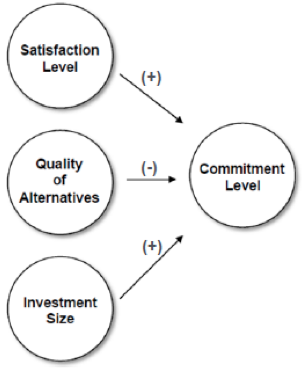You’ll find that there are a lot of things on the marketing course that you can apply to real-life situations. One of the most interesting lectures I have had was the first lecture of Relationships and Services Marketing. Commitment is the strongest predictor of relationship length when controlling for intimacy and passion. So how do you make a relationship last? There are three determinants of commitment: satisfaction level, quality of alternatives, and investment size.
If Hannah is satisfied with her relationship with Bob, Hannah will remain in the relationship. The higher the satisfaction level, the higher the commitment. Satisfaction increases when benefits increase and/or costs decrease. Benefits can be material or psychological. We usually understand how satisfied we are by comparing with previous relationships or those relationships of significant others.
If Hannah’s quality of alternatives are low, she will remain in the relationship with Bob. The lower the quality of alternatives, the higher the commitment. If there are highly attractive alternatives (e.g. super attractive Ben that is really into Hannah), this will lower commitment.
If Hannah has invested a lot into her relationship with Bob, Hannah will remain in the relationship. The higher the investment size, the higher the commitment. Invested resources enhance commitment because of the increase in cost of ending the relationship. This can be material (e.g. buying an apartment together) or psychological (e.g. time spent together).
Satisfaction is the most important driver of commitment, so if quality of alternatives are high and investment is low, but Hannah is very satisfied, she is still more likely to remain in the relationship.
So, if you are in a relationship or will be in one in the future, remember, high satisfaction level, low quality of alternatives, and high investment size will increase commitment.




